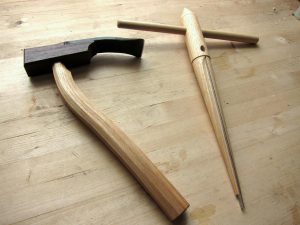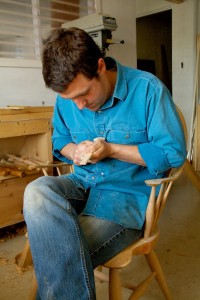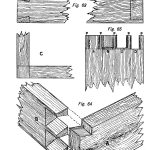We may receive a commission when you use our affiliate links. However, this does not impact our recommendations.
I caught up yesterday with Tim Manney, a designer and producer of chairmaking tools in Portland, Maine. Here’s our conversation, the first installment in a new series of Q&A posts with experts and professionals in the woodworking community. And there’s a twist to this series – each interviewee will tell me who I should talk to next. Enjoy!
Dan: What are the tools and machines you use to make your specialty chairmaking tools?

Adze and tapered reamer, two chairmaking tools you should have in your kit for traditional Windsors.
Tim: I make a reamer that is used to make the tapered leg to seat joint of a Windsor chair, and an adze designed to hollow out chair seats. Making the reamer is a highly precise process, because each one has to be an exact six-degree taper. Ninety percent of my time making reamers is spent at the lathe and I use a duplicator for repeatability. I make the adze blades at the forge and I shave the handles with a drawknife. Other than the lathe, my band saw and drill press help out, but otherwise, I work with planes, knives, chisels and scrapers. My workshop is tiny and hand tools accomplish a lot and require a minimum of space.
Dan: What is the philosophy behind your business?
Tim: I try to design and make tools that work exceptionally well. When someone picks up a tool that I have made and uses it for the first time I want them to think, “THIS is what an adze is supposed to feel like.” That feeling gets people excited and that excitement is one of the things that I am going for.
Dan: Where do you find inspiration and new ideas?
Tim: My aesthetic inspirations come primarily from Swedish-style carved wooden spoons, a la Wille Sundqvist. They are a model of simplicity and elegance, a true marriage of form and function. I try to make objects that have that kind of visual simplicity. Spoon carving is a great way to develop a sense of the subtlety of shape, learn how to cut wood cleanly in three dimensions – and it’s fun.
Tool ideas come from using tools that don’t work as well as I want them to. The adze is a perfect example of that. There was not an adze that was commercially available that either Pete Galbert or I liked. So we collaborated and designed this tool to cut the way that we wanted an adze to cut, and be fairly intuitive for new users to learn how to use.
Dan: Who should I talk to next?
Tim: On that note, I think you should talk to a spoon carver like Jarrod StoneDahl. He is incredibly skillful.
Thanks, Tim! Very impressive stuff.
Note to readers: We are releasing our latest value pack on Friday, a chairmaking bundle. Stay tuned for the release. Click here to snap it up!
–Dan Farnbach
Here are some supplies and tools we find essential in our everyday work around the shop. We may receive a commission from sales referred by our links; however, we have carefully selected these products for their usefulness and quality.










